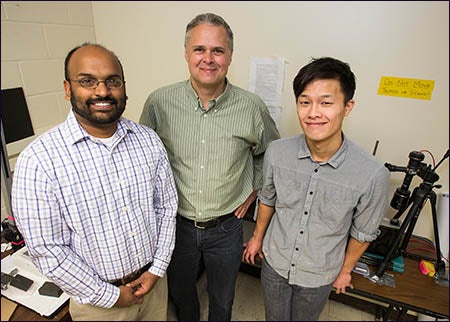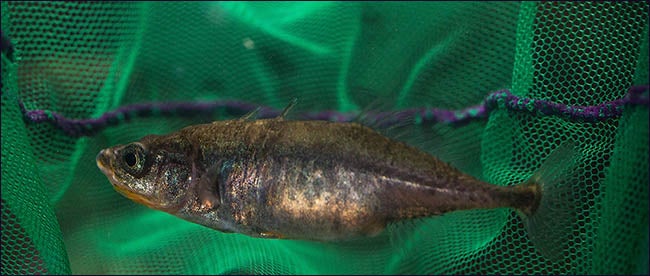VALUABLE INSIGHTS
ECU research could point to more effective medicines
McKinnon, professor and chair of biology at ECU, is studying the threespine stickleback to find out why the bright colors of the male, which help it attract mates, sometimes show up in females. The findings could give scientists insights into the genes behind sex differences and ultimately help them tailor medicine to better suit patients’ sex and race.

Researchers pictured are, left to right, ECU biology professor Chris Balakrishnan, biology chair Jeffrey McKinnon and biology Ph.D. student Lenny Yong.
McKinnon and co-investigators Chris Balakrishnan of ECU and Catherine Peichel of the Fred Hutchinson Cancer Research Center in Seattle, have received a $316,241 grant from the National Institute of General Medical Sciences to fund the three-year study.
The fish lives on the northern Pacific and Atlantic coasts of Europe and Asia as well as North America. Fish from many populations spend most of their lives in the ocean but breed in brackish and fresh water. Purely freshwater forms have also evolved, independently on different continents and islands.
McKinnon has studied the threespine stickleback for much of his career. His early work helped develop the stickleback as a model organism for genetic and evolutionary studies since it shows great morphological variation throughout its range.
“We hope to … better understand the genetic mechanisms responsible for causing seemingly male traits to appear in female animals in some populations,” McKinnon said. “We also want to know if females who possess one male-like trait are only masculinized for that trait or more generally.”
The research will shed light on “whether some male-like traits are present in females because they benefit females or as a byproduct of the benefits they provide to males and vice-versa,” McKinnon said. “Given the interest in better tailoring medicine by gender and ethnicity, we may provide useful insights on matters important to human health.”
ECU doctoral student Lenny Yong is playing a key role in this research program and helped write the grant application. The grant will also support the research of two master’s students and a number of undergraduates who will be trained in behavioral studies, genetics and genomics.

Research on the threespine stickleback, pictured below, focuses on the mechanisms that enable some females to display male-like traits.